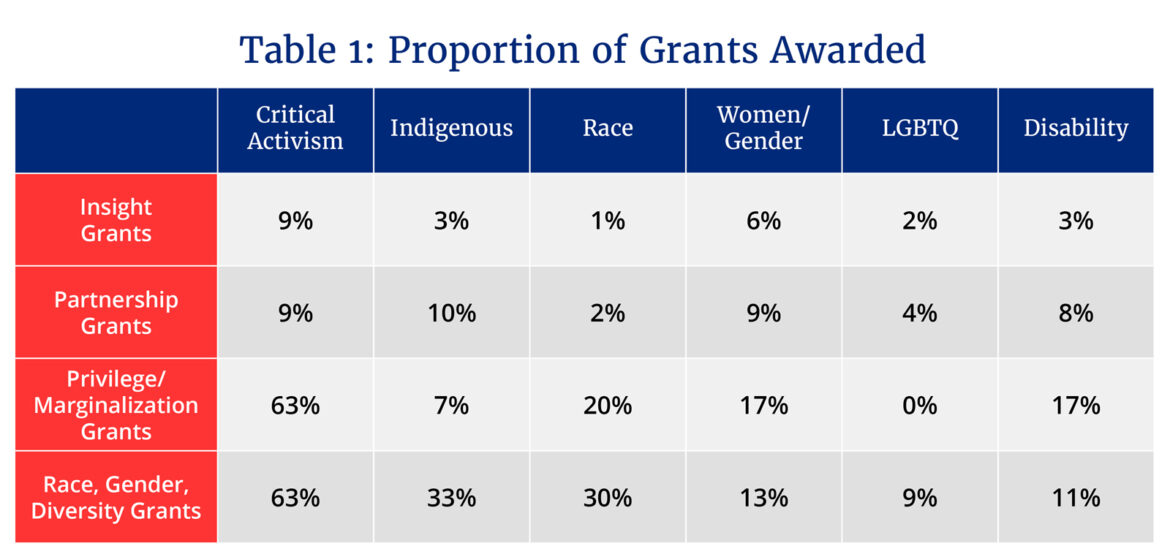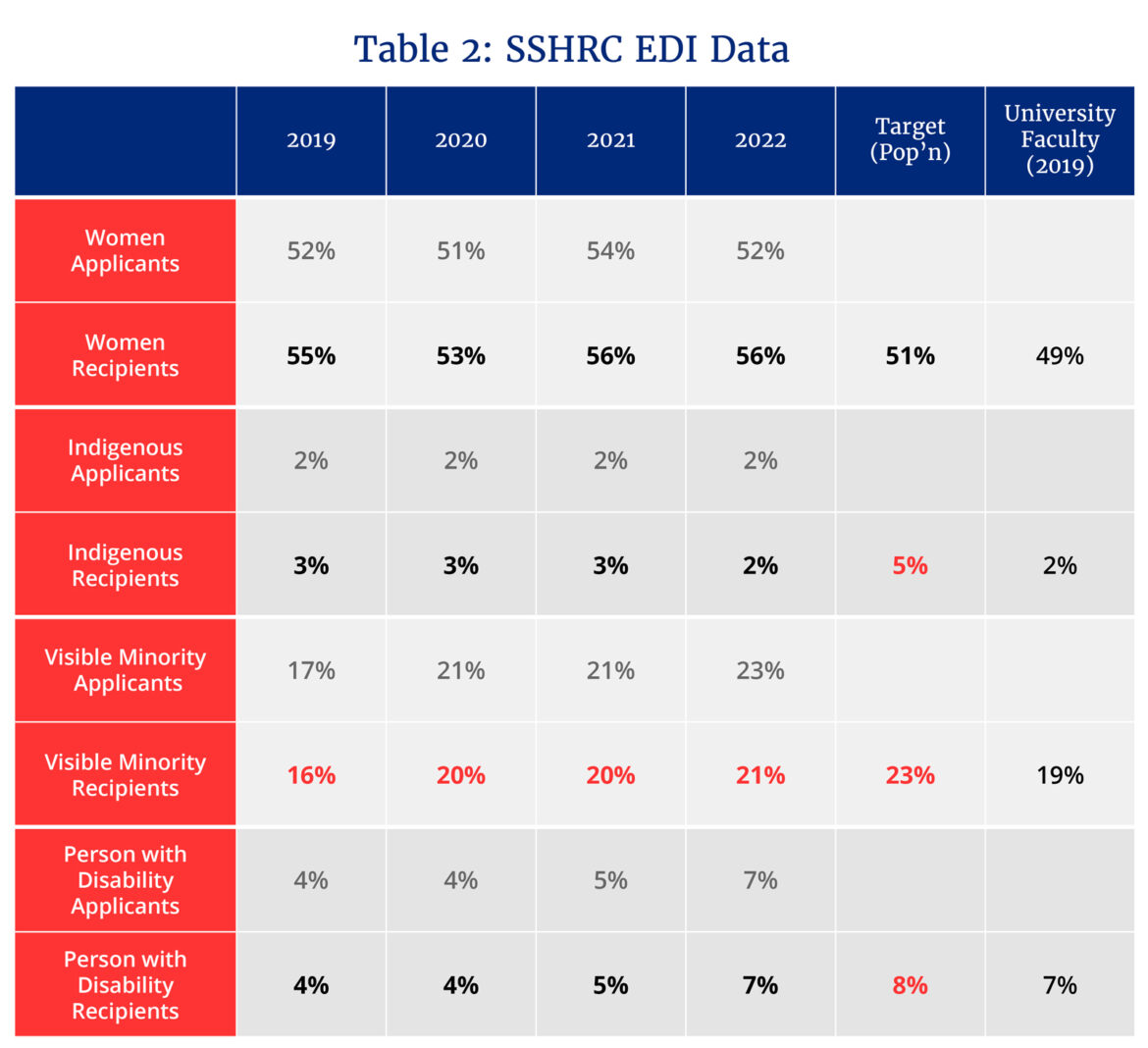There’s been a lot of discussion and debate in recent months about the extent to which the Canadian government and the country’s universities and colleges are being influenced by the steady rise of equity, diversity, and inclusion (EDI).
Some argue it’s a serious problem that is coming at the expense of the pursuit of knowledge and truth. Others argue these concerns are overstated. In a national post-secondary landscape with hundreds of public and private institutions, thousands of faculty members, and millions of students, it can be difficult to generalize. Yet there have been few efforts to systematically analyze the actual effect of EDI on Canadian public institutions.
To explore this issue, I completed a review of how the Social Sciences and Humanities Research Council (SSHRC)—a major federal granting agency at the intersection of government and academia—has implemented EDI. It may not be a perfect proxy for the post-secondary sector as a whole but SSHRC’s policies and programs provide a useful empirical window into these broader debates.
What did my analysis find? As SSHRC declares its mission to “create a culture where embedding equity, diversity, and inclusion (EDI) considerations into all aspects of research is second nature”, it’s beginning to face its own institutional challenges.
The evidence that I discovered shows an institution in a tug of war between two versions of equity, diversity, and inclusion: the “soft” EDI of what we’ve historically seen as affirmative action and the “hard” EDI of new critical social justice activism. How SSHRC and other granting agencies manage this tension will determine the future quality of Canadian research.

What does SSHRC say about EDI?
SSHRC (pronounced “shirk”) is one part of the “tri-council” of federal granting agencies, along with its siblings the Natural Sciences and Engineering Research Council (NSERC) and the Canadian Institutes of Health Research (CIHR).
The agency’s statutory mandate is to “promote and assist research and scholarship in the social sciences and humanities” and to advise the federal minister of Innovation, Science, and Economic Development. SSHRC is primarily responsible for funding and overseeing a variety of programs, partnerships, scholarships, grants, and fellowships for students and researchers. Full disclosure: my own research has benefited immensely from SSHRC funding, and I currently hold a SSHRC Insight Grant.
In 2023/2024, SSHRC’s budget was forecast to rise to $1.16 billion, a growth of over $100 million from the previous year. Of that budget, $694 million is dedicated to grants, fellowships, and scholarships.
SSHRC’s commitment to EDI is now ubiquitous. Its page on “Equity, diversity, and inclusion in the research enterprise” links to eleven different EDI-related initiatives, services, and websites. It encourages researchers to incorporate “EDI-focused measures” including “relevant identity factors” to “increase the excellence of research projects, by valuing and fostering the inclusion of diverse experiences, approaches, knowledge and ways of knowing.” SSHRC now has established advisory committees on anti-Black racism and systemic ableism. It has also developed an Indigenous Research Statement of Principles that “recognize[s] the scholarly contributions of Indigenous knowledge systems.”
SSHRC’s most comprehensive commitment to EDI comes in the form of the tri-council’s 2018-2025 EDI Action Plan, which explicitly seeks to “create a culture where embedding equity, diversity and inclusion (EDI) considerations into all aspects of research is second nature.” This plan includes what the tri-council calls an “EDI Charter,” setting out targets for year-over-year increases in the number of students and faculty from “underrepresented groups”—women, Indigenous Peoples, persons with disabilities, visible minorities, and “members of LGBTQ2+ communities”—attending, teaching, and receiving awards at Canadian postsecondary institutions.
Using affirmative action to meet EDI quotas
Interestingly, although SSHRC is infused with EDI, it rarely engages in the most hardline and embarrassing language that informs much of Canada’s higher education EDI bureaucracy. For example, SSHRC’s materials contain no mention of dismantling “whiteness,” and only a few vague references to decolonization (which the tri-council calls “a highly complex topic with no single definition or interpretation”). Even SSHRC’s Indigenous Research Statement of Principles, with its nod to “Indigenous knowledge systems,” views Indigenous research as complementary to “SSHRC’s commitment to scholarly excellence.” The main goal of most of the EDI initiatives is a desire to “boost participation and inclusion of underrepresented and disadvantaged groups, so research teams are more representative of the diverse pool of Canadian talent.” While SSHRC may have shifted its language to the more fashionable “EDI,” what it’s promoting is affirmative action.
Affirmative action is not neutral, particularly when it involves the firm targets or quotas present in many of SSHRC’s programs. For example, the EDI Action Plan for Canada Research Chairs (CRCs), some of the most prestigious academic positions in the country, includes “equity targets” until 2029, to ensure that CRCs are awarded to underrepresented groups, according to their proportion of the Canadian population. Universities are now advertising CRC positions that explicitly exclude candidates who are white and male.
Likewise, SSHRC is now testing EDI requirements for partnership grants, Ph.D. scholarships, and postdoctoral fellowships. It is now mandatory for Ph.D. and postdoctoral applicants to complete a “Diversity Considerations in Research Design module,” though that part of the application is not “subject to merit review this year” and is merely to “build awareness.” So far, concrete EDI requirements are not yet a part of applications for major permanent research awards.

Taking a more hardline approach to EDI
However, SSHRC’s EDI commitment has gone well beyond affirmative action with the recent establishment of two new non-permanent grants that invoke the “hard” EDI of critical social justice activism. In 2023, SSHRC awarded 30 grants of up to $30,000 each for “Shifting Dynamics of Privilege and Marginalization,” with the application description noting that “Our colonial past, racism and slavery continue to shape processes of marginalization and privilege today.”
A year before, SSHRC awarded $19.2 million in funding for 46 grants of up to $450,000 for its Race, Diversity, and Gender Initiative to create partnerships to study disadvantaged groups. The program description encouraged projects that seek to “achieve greater justice and equity,” and its list of “possible research topics” included questions such as “How can cisgender and straight masculinity be reinvented for a gender-equitable world?” and “Which mechanisms perpetuate White privilege and how can such privilege best be challenged?” The language used in these new grants denotes the clearest shift yet towards more activist priorities in federal research grant funding.
SSHRC data on EDI
To determine whether the “hard” EDI of social justice activism has had a real effect on the types of projects that received funding for SSHRC grants, I conducted a content analysis of the titles of 680 grants awarded under four programs between 2022-23, the latter two of which are explicitly EDI-focused:
- Insight Grants announced in 2023, which “support research excellence in the social sciences and humanities,” valued between $7,000 and $400,000 over five years. (504 total)
- Partnership Engage Grants announced in 2023, which provide short-term support for a partnership with a “single partner organization from the public, private or not-for-profit sector,” valued between $7,000 and $25,000 for one year. (100 total)
- Knowledge Synthesis Grants to study “Shifting Dynamics of Privilege and Marginalization” announced in 2023, valued at $30,000 for one year. (30 total)
- Race, Gender, and Diversity Initiative grants announced in 2022, which support partnerships “on issues relating to systemic racism and discrimination of underrepresented and disadvantaged groups,” valued at “up to $450,000” over three years. (46 total)
First, I categorized each grant recipient according to whether their project title was clearly adopting a critical activist perspective (if there was any uncertainty, it was categorized as “no”).
I then categorized each grant according to which EDI identity markers the projects covered—Indigenous Peoples, women/gender, LGBTQ+, race, and disability (including mental health).
As Table 1 shows, the contrast between the two “traditional” grants and the two new EDI-focused grants was striking. Fully one-third of grants in the Race, Gender, and Diversity initiative focused on Indigenous Peoples, and 30 percent mentioned race or racism (compared with 3 percent and 1 percent of the Insight Grants).
The disparity is especially pronounced when you compare the Race, Gender, and Diversity grants to the Insight Grants, where there was an 11-1 ratio in the proportion of grants awarded on the topic of Indigenous peoples (33 percent versus 3 percent). There was also a 30-1 ratio in the proportion of grants awarded on the topic of race (30 percent versus 1 percent).

It might seem obvious that the two EDI-focused grants produced so many recipients with explicitly activist titles (63 percent compared with 9 percent of traditional grants). Yet it didn’t need to be this way. Examples of non-activist titles of Race, Gender, and Diversity Initiative recipients included “Understanding Race and Racism in Immigration Detention” and “Open-Access Education Resources in Deaf Education Electronic Books as Pedagogy and Curriculum.” One can study marginalized communities without engaging in social justice activism.
However, most of the EDI-focused grants awarded left no doubt as to the type of research that would be undertaken. Choice titles included:
- “‘So what do we do now?: Moving intersectionality from academic theory to recreation-based praxis” ($450,000 grant awarded)
- “Queering Leadership, Indigenizing Governance: Building Intersectional Pathways for Two Spirit, Trans, and Queer Communities to Lead Social and Institutional Change” ($446,000 grant awarded)
- “Carceral Intersections of Gender Identity, Sexual Orientation and Trans Experience in Confronting Anti-Black Racism and Structural Violence in the Prisoner Reentry Industrial Complex” ($400,075 grant awarded)
In addition to grant titles, I also examined SSHRC’s diversity data on grant recipients from “underrepresented groups” for all major grants in SSHRC’s own EDI dashboard. This included Insight Grants, Insight Development Grants, Partnership Grants, and Connection Grants (diversity data for the two new EDI-focused grants described above were not available).
Table 2 provides these numbers alongside SSHRC’s equity targets for 2024/2025 and the groups’ proportion of Canadian university faculty as of 2019. Numbers in red show “under-performance” in the applicant-recipient ratio and SSHRC’s own targets.

Four things are notable. First, only one of SSHRC’s four target groups (visible minority applicants) has been underrepresented in terms of the applicant-recipient ratio. Second, while women are the only group who have exceeded SSHRC’s equity target, the percentage of recipients has been growing rapidly for visible minority applicants and persons with a disability. Third, no target group is underrepresented relative to its proportion of university faculty members, with women (56 percent of recipients) especially outperforming their faculty proportion (49 percent). Finally, Indigenous grant recipients (2 percent) are underrepresented relative to their proportion of the overall population (5 percent), but not relative to their proportion of university faculty members.
Damaging the pursuit of truth
The above analysis leads me to three broad conclusions. First, while the language of EDI has permeated SSHRC, the federal agency oscillates between the “soft” EDI of affirmative action and the “hard” EDI of critical social justice activism. Most of the time, SSHRC focuses on achieving “equity targets” and frames EDI as complementary to research excellence. However, SSHRC’s new EDI-themed grants explicitly adopt activist language, and it is little wonder that those awards have been dominated by activist projects.
Second, when it comes to the “soft” EDI of affirmative action, SSHRC’s policies are clearly having their intended effect for all groups except Indigenous Peoples. The number of grants awarded to women, visible minority applicants, and persons with a disability is rising. Grants are being awarded to members of these three groups at a proportion equal to or greater than their share of university faculty, and in the case of women, well above their share of the overall population. At this rate, it will soon be inaccurate for SSHRC to refer to “underrepresented groups” when it comes to prestigious national grants.
Finally, the “hard” EDI of critical social justice activism poses the biggest threat to SSHRC’s commitment to research excellence. While there are important critiques of the effects of “soft” EDI of affirmative action, it does not necessarily pose the same existential threat to research excellence. But the “hard” EDI of critical social justice activism is utterly incompatible with the objective pursuit of truth. One need only skim the titles of grants awarded under SSHRC’s two new EDI-focused initiatives to see how far they have strayed from the objective, empirical knowledge creation that we expect our national granting agencies to fund. Ironically, the more an award is pitched in terms of “diversity,” the less intellectually diverse the recipients seem to be. Thankfully, such activist research remains primarily confined to the new (and for now temporary) EDI-focused grants.
If the federal government wants universities to keep the public’s trust, it should avoid any future activist-themed grants and ensure that granting agencies eschew social justice priorities. Federal granting agencies using taxpayer dollars should be explicit that their primary commitment is to promote excellence via the creation and dissemination of objective, falsifiable research knowledge. The university is supposed to function as a system of knowledge production. Policies that openly tie research to activist political ends threaten to undermine that very system.




